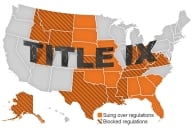You have /5 articles left.
Sign up for a free account or log in.
Last week, The Harvard Crimson and then The New York Times reported that, in a cost-cutting move, Harvard University would no longer provide cookies for faculty meetings, saving approximately $500 per meeting. A Harvard faculty member was quoted as saying, “We are sharing the pain with the undergraduates.” Meanwhile, due to the economic downturn, Harvard’s endowment has dropped to a mere $27 billion.
GIVE ME A BREAK!!!!
It is high time to educate the supporters of education and publications that cover higher education that Harvard’s cookie crisis, however traumatic it may be in Cambridge, is not remotely illustrative of the depth of the economic crisis being faced by the colleges that serve those who need education the most. I’m the chancellor of an open-admission, two-year college within the 14th poorest congressional district in the country; we have half as many freshmen as Harvard, yet only a minuscule amount of the resources. We have had a 35 percent increase in enrollment since 2006, yet kept tuition the same. Our state appropriations – already the 47th lowest in the nation in terms of support for higher education – have never recovered from budget cuts back in 2002. Our budget was flat last year, at best will be flat this year, and will very likely decline in fiscal year 2012.
Approximately 86 percent of our degree-seeking students receive some type of financial assistance, and many work full time while going to school. Most are first-generation college students, and a disproportionate number are single parents. Yet, we are breaking the cycle of poverty and providing future opportunities for students who, because of admission standards and financial needs, don't choose which college to attend, but whether to go at all.
Few people outside of the Ozarks know about Missouri State University-West Plains, where we don’t spend $500 every meeting on cookies! Maybe it’s time to stop drawing attention to the alleged sacrifice of doing without cookies and ask what’s wrong with a system where some institutions have that much money in the first place. Another example is Princeton University spending $5,000 each on chairs for its new library. Every time I read about something like this I want to shout that a million-dollar gift to an institution like Harvard or Princeton is a drop in the bucket, while the same gift to a two-year, rural college is a tsunami.
Who wants to endow a chair at our school? Currently we have none.
Who wants to modernize facilities for our nursing program? We have a waiting list of students wanting to be accepted into the program, but because of program limitations, we cannot admit them. This is an extremely successful program in which virtually 100 percent of our graduates find employment upon graduation.
Who wants to fund our Honors Program for an overseas trip? Many of our students have never traveled farther than 100 miles, let alone visited another country.
Let me tell you what we have cut back.
- For 13 years we have been trying to add classrooms and facilities for the 75 percent of our students who require developmental classes before they are ready for freshman-level math and English. Last year we finally got $8 million appropriated for two buildings. This appropriation passed the legislature and was signed into law by the governor, but because of the lack of state revenues has now been withheld indefinitely.
- Our Honors Program, which includes some of our best and brightest students, no longer visits China, a country that will have a greater and greater impact on the world in which they will live, work and compete.
- We have closed our Center for Business and Industry Training, and we are closing one of our satellite classroom facilities.We have eliminated, consolidated, or reduced to part time numerous staff positions.
- Our faculty and staff, who always go above and beyond the requirements of their jobs, have been underpaid for years, did not receive a raise last year, will not receive one this year, and will be fortunate to have a job next year. Compare the average salary of our professors and assistant professors, $53,333 and $40,307, to the average salary for Harvard’s professors and assistant professors, $192,600 and $101,400. While I am well aware that Missouri State-West Plains is not a four-year college with elite graduate programs, I am also well aware that faculty at two-year colleges educate almost half of the undergraduates in the United States.
While this information is specific to my campus, you will find similar examples of administrators stretching the dollar at two-year campuses across the country.
Let me recognize that Harvard is a world-class institution, and Ivy League universities provide unique educational opportunities. That is not the issue. While I concede that the “cookie cutback” and subsequent faculty comment are not indicative of all of Harvard’s programs, they do serve to highlight a very real problem – the lopsided support of different institutions within higher education.
One can make a sound argument that a Harvard education is worth more than an education at Missouri State-West Plains. But, when you remember that our campus has half as many freshmen as Harvard, that our institution is the only option for many of our students, and that our endowment of $1.7 million is just pennies compared to Harvard’s $27 billion, is a Harvard education worth over 15,000 times more? Let me put it another way – are our students 15,000 times less worthy of the benefits of higher education? We must find a way for supporters of education to contribute in a more meaningful and balanced approach. Otherwise, a growing philanthropic egoism widens the chasm between those who have and those who can’t even have the opportunity to have.
Are we just going to keep saying, “That’s the way the cookie crumbles?”








